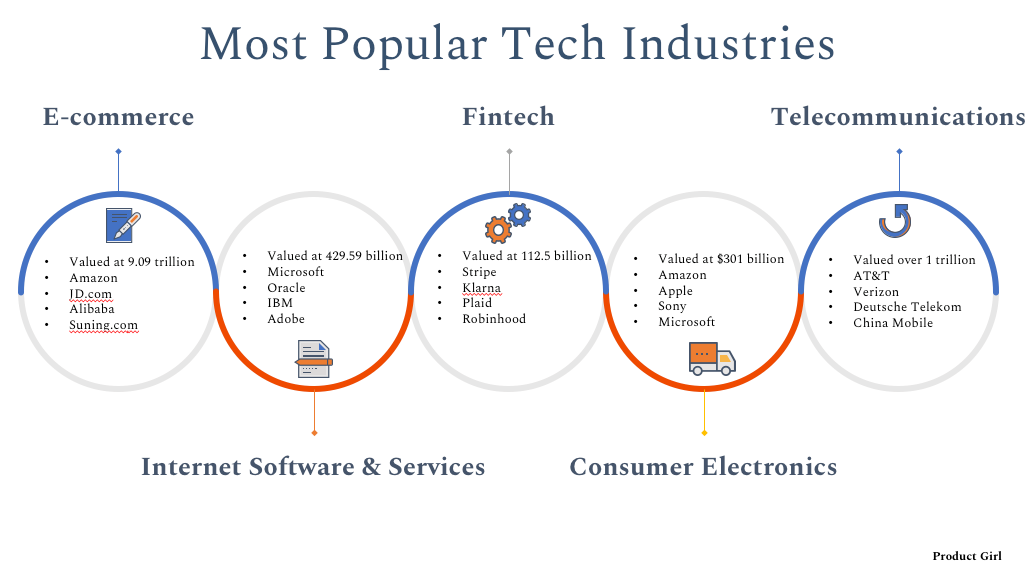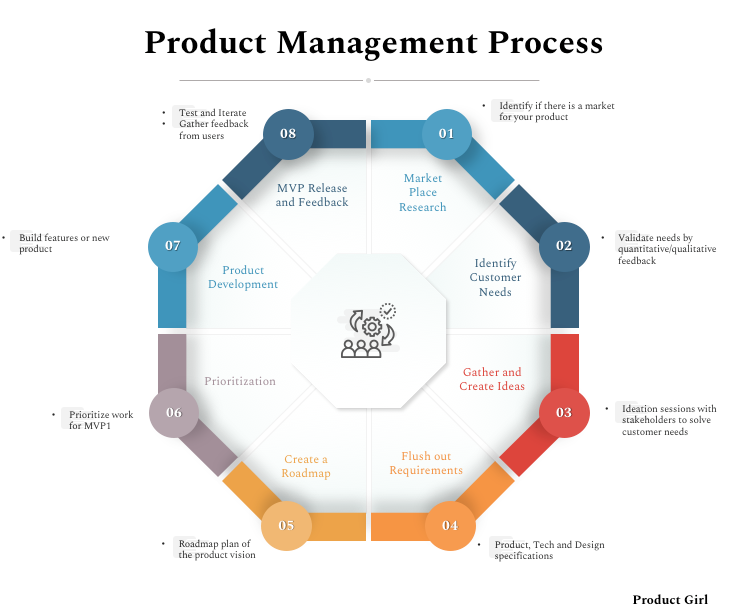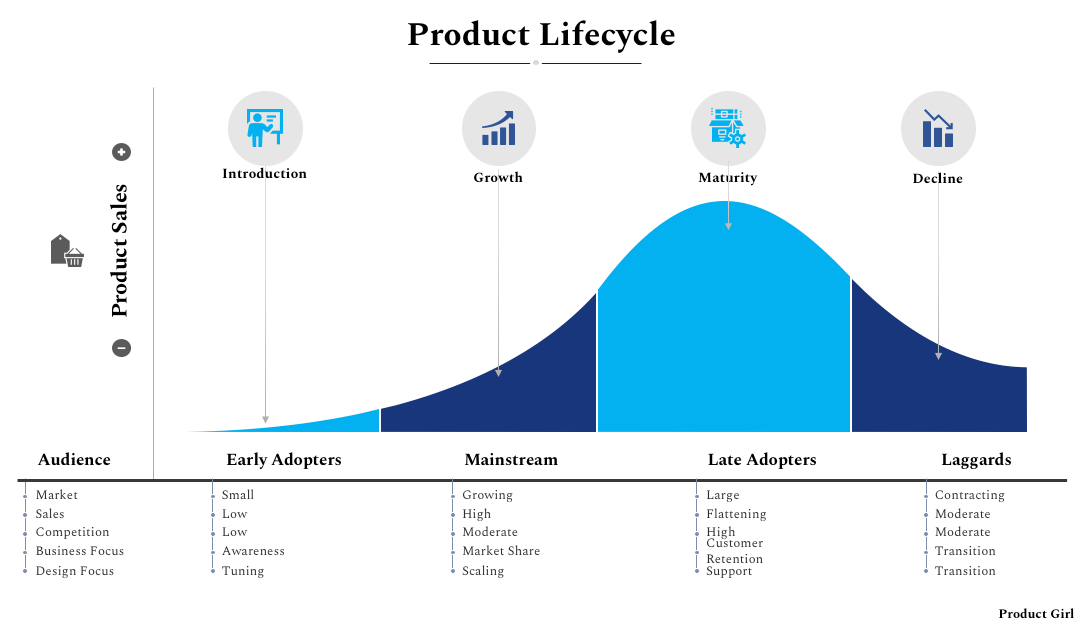Product management is based on curiosity and the willingness and desire to learn. Showing initiative to want to learn shows that you would be a great one. The nuances of product management make learning it a bit of a challenge. All too often I'm asked "Where do I look? Who do I listen to? What courses do I take?".
Since the path to learning product management can lead into mixed and sometimes conflicted information it's best to take the route of real-world experience. Working on side projects, researching industries you want to be involved in, and understanding the product management process is a great way to start learning. Hopefully, I can guide you in a way that is feasible and makes sense.
The following is an outline on the different ways to learn product management to better prepare yourself for your first role as a PM.
Learning Product Management
- Study different industries that you are passionate about
- Understand the product management process
- Understand the product management lifecycle
- Start your own side project to build product skills
- Work on a side project with another PM
Study different industries
The tech sector is comprised of a broad range of products and services. IT has grown significantly and expanded to different industries as technology becomes more relevant in our everyday lives. There are hardware products like mobile devices, wearable technology, home appliances, televisions, and personal computers. Then, software products like enterprise software for businesses that involve SAAS, PAAS, and IAAS products.
With an impressive fleet of products the industry offers, learning about the different IT sectors will help to choose the best career path that matches your interest. Also, learning about different IT sectors will give you an idea of the growth of some industries and the decline of others. This can help to determine the longevity of an industry in your career decisions and which path to take that will offer the most opportunities for creativity, innovation as well as personal growth.
Also, the tech industry is constantly changing and evolving. Merger and acquisitions are becoming increasingly popular and almost a common practice in today's corporate sector as they allow companies to combine resources and knowledge. This creates a competitive space to have a leg up on it's competitors. For example, computer companies are competing with consumer electronics and telecommunication markets as technologies become more integrated in multifunctional devices.

Product Management Process
The product management process focuses on bringing a new product or feature to market. The process lays the foundation of understanding the "why" of a customers needs and how your product can be a solution. The goal of this process is to establish a smooth transition through the various stages of the product management lifecycle to implement an idea from discovery to launch.

Behind every great product is a strategy that evolves through the product management process. This endless flow of hypothesis, assumptions, experimentations, refining the experience, learning from it, and developing a product encompasses the product management process.
This process is the baseline to deliver a product to market or when evaluating whether to add a new feature to an existing product. Each organizations operations may be slightly different, but the process is relatively the same.
Product Management Lifecycle
Once you know the basics of the product management process it's important to understand the lifecycle of the feature or new product that has been introduced to the market. The product lifecycle will describe the journey of a new product from it's initial introduction into the market until it is discontinued.

As a Product Manager it is important to know which stage your product is at in the lifecycle process so you know which decisions need to be made. Being a good Product Manager entails keeping track of the product throughout it's lifecycle and thinking about the possible changes that could happen in the future.
Remember your product will need to evolve at the various stages of the lifecycle rather than fight against change. This will mean that your skills as a PM will also need to evolve to meet these changes and/or uncertainties.
Start your own side project
Most job postings ask for some product level experience, but how do you get experience in a career that has no clear pathway in. Doctors go to medical school, Lawyers go to law school, and Dentist go to dental school, but where do PM's go. Even with extended education for a specified career the best experience is doing the actual job. The good news is that you most likely already have the skills and knowledge to being a product manager now you just need to find a way to demonstrate that.
Starting a side project helps to show initiative to companies and exhibits your creativity. There is no need to overcomplicate starting your own side project. It can be basic and simple. Don't be overwhelmed by trying to gather a team. You don't need to start a start-up to create a side project.
Steps to starting your own side project
1. Take Action
2. Create a Plan
3. Execute
Take Action
Take action by choosing a product you are passionate about. Ask yourself 'why' you are passionate about this particular product and 'why' you would like to improve it. Then, you can figure out the 'what' you would like to add. The easiest pathway to starting a side project is improving on an existing product. This could be simple like adding a small feature that delivers a lot of value.
🚨Important Note: Remember picking something you're passionate about will help you to innovate better and you'll be more motivated to make time for it.
Create a Plan
Creating a plan to bring your feature to market will help to provide speed, support, competitive advantage, confidence and flexibility to make it a success. Without a plan and process in place the journey will be long and painful. Starting with the product management process will help execute your vision at different stages of the products lifecycle.
🚨Important Note: Your plan should involve how you will manage your time. Prioritizing and blocking off your calendar to make time for your project is another important attribute of being a Product Manager.
Execute
Finding your feature and creating a plan is half the battle. Execution is key. Execution means everything. It shows you have the intensity and focus to make things happen. A lot of game changing ideas never come to fruition because of lack of execution. Execution will forever be a disciplined process and even though taking action and creating a plan is admirable execution speaks to delivery.
Work on side projects with other PM's
Having the opportunity to collaborate with cross-functional teams, experiment, innovate, showcase your passion for the trade, gain skills and learn new ones will prove to be extremely beneficial. Learning how to solve a real problem that a specific industry is facing and how they find that unique solution will be valuable.
Working on a side project shows that you have the technical skills, motivation, passion, product sense, and grit to become a great product manager. The benefits of working on a side project is that it will help you learn and level up quickly. This will prove beneficial when you land your first PM role as the learning curve will be slightly less because of the experience you acquired. Also, it will allow you to develop the key skills to become successful in your first PM role.
These skills include time management, resource management, communication, execution, strategy, technical skills, design skills, prioritization, and igniting your product sense. Being able to exercise these skills makes you aware of the challenging aspects of being a product manager.
The following are a few of the benefits of taking on a side project
- An opportunity for cross-functional collaboration
- Learning how to deliver and execute on an idea
- Freedom to learn and acquire new skills
- Provide independence and creative outlets to showcase your work
- Learning to work efficiently
- Build a valuable network
Above all, working on a side project will give exposure to the role, responsibilities, and challenges a PM faces allowing you to make the decision if being a Product Manager is right for you.
Final Words 📖
Learning the roles and responsibilities of a product manager is an exciting journey. The mindset of being able to tackle some of the world's greatest challenges and provide solutions is a rewarding experience. It's important to not get discouraged as no two path's are the same. Some people may fall into being a Product Manager while others may need to take on a side project, but no matter the path it's a flexible journey filled with endless possibilities. Remember to enjoy it!
Next Steps 🚀
1. Most Popular Tech Industries
2. Starting Your Own Side Project
3. Working on a side Project
4. Landing your first PM Role